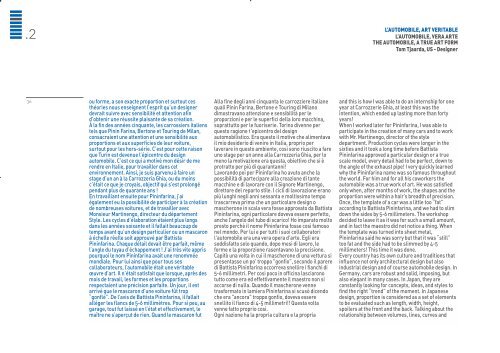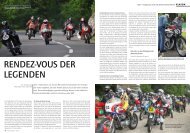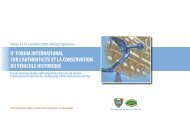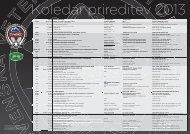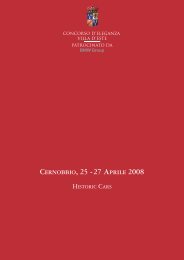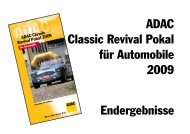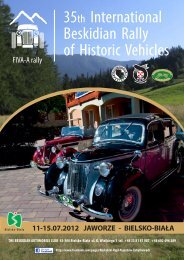FORUM INTERNATIONAL SUR L'AUTHENTICITE DU VEHICULE HISTORIQUE ...
FORUM INTERNATIONAL SUR L'AUTHENTICITE DU VEHICULE HISTORIQUE ...
FORUM INTERNATIONAL SUR L'AUTHENTICITE DU VEHICULE HISTORIQUE ...
You also want an ePaper? Increase the reach of your titles
YUMPU automatically turns print PDFs into web optimized ePapers that Google loves.
.2<br />
36<br />
ou forme, a son exacte proportion et surtout ces<br />
théories nous enseignent l’esprit qu’un designer<br />
devrait suivre avec sensibilité et attention afin<br />
d’obtenir une réussite plaisante de sa création.<br />
À la fin des années cinquante, les carrossiers italiens<br />
tels que Pinin Farina, Bertone et Touring de Milan,<br />
consacraient une attention et une sensibilité aux<br />
proportions et aux superficies de leur voiture,<br />
surtout pour les hors-série. C’est pour cette raison<br />
que Turin est devenue l’épicentre du design<br />
automobile. C’est ce qui a motivé mon désir de me<br />
rendre en Italie, pour travailler dans cet<br />
environnement. Ainsi, je suis parvenu à faire un<br />
stage d’un an à la Carrozzeria Ghia, ou du moins<br />
c’était ce que je croyais, objectif qui s’est prolongé<br />
pendant plus de quarante ans !<br />
En travaillant ensuite pour Pininfarina, j’ai<br />
également eu la possibilité de participer à la création<br />
de nombreuses voitures, et de travailler avec<br />
Monsieur Martinengo, directeur du département<br />
Style. Les cycles d’élaboration étaient plus longs<br />
dans les années soixante et il fallait beaucoup de<br />
temps avant qu’un design particulier ou un mascaron<br />
à échelle réelle soit approuvé par Battista<br />
Pininfarina. Chaque détail devait être parfait, même<br />
l’angle du tuyau d’échappement ! J’ai très vite appris<br />
pourquoi le nom Pininfarina avait une renommée<br />
mondiale. Pour lui ainsi que pour tous ses<br />
collaborateurs, l’automobile était une véritable<br />
œuvre d’art. Il n’était satisfait que lorsque, après des<br />
mois de travail, les formes et les proportions<br />
respectaient une précision parfaite. Un jour, il est<br />
arrivé que le mascaron d’une voiture fût trop<br />
“gonflé”. De l’avis de Battista Pininfarina, il fallait<br />
alléger les flancs de 5-6 millimètres. Pour si peu, au<br />
garage, tout fut laissé en l’état et effectivement, le<br />
maître ne s’aperçut de rien. Quand le mascaron fut<br />
Alla fine degli anni cinquanta le carrozziere italiane<br />
quali Pinin Farina, Bertone e Touring di Milano<br />
dimostravano attenzione e sensibilità per le<br />
proporzioni e per le superfici della loro macchina,<br />
soprattutto per le fuoriserie. Torino divenne per<br />
questo ragione 1'epicentro del design<br />
automobilistico. Era questo il motive che alimentava<br />
il mio desiderio di venire in Italia, proprio per<br />
lavorare in questo ambiente, così sono riuscito a fare<br />
uno stage per un anno alla Carrozzeria Ghia, per lo<br />
meno la motivazione era questa, obiettivo che si è<br />
protratto per più di quarantanni!<br />
Lavorando poi per Pininfarina ho avuto anche la<br />
possibilità di partecipare alla creazione di tante<br />
macchine e di lavorare con il Signore Martinengo,<br />
direttore del reparto stile. I cicli di lavorazione erano<br />
più lunghi negli anni sessanta e moltissimo tempo<br />
trascorreva prima che un particolare design o<br />
mascherone in scala vera fosse approvato da Battista<br />
Pininfarina, ogni particolare doveva essere perfetto,<br />
anche l’angolo del tubo di scarico! Ho imparato molto<br />
presto perchè il nome Pininfarina fosse così famoso<br />
nel mondo. Per lui e per tutti i suoi collaboratori<br />
l'automobile era una vera opera d'arte. Egli era<br />
soddisfatto solo quando, dopo mesi di lavoro, le<br />
forme e la proporzione rasentavano la precisione.<br />
Capitò una volta in cui il mascherone di una vettura si<br />
presentasse un po' troppo "gonfio", secondo il parere<br />
di Battista Pininfarina occorreva snellire i fianchi di<br />
5-6 millimetri. Per così poco in officina lasciarono<br />
tutto come era ed effettivamente il maestro non si<br />
accorse di nulla. Quando il mascherone venne<br />
trasformato in lamiera Pininfarina si scusò dicendo<br />
che era "ancora" troppo gonfio, doveva essere<br />
snellito il fianco di 4-5 millimetri!! Questa volta<br />
venne fatto proprio così.<br />
Ogni nazione ha la propria cultura e la propria<br />
L’AUTOMOBILE, ART VERITABLE<br />
L’AUTOMOBILE, VERA ARTE<br />
THE AUTOMOBILE, A TRUE ART FORM<br />
Tom Tjaarda, US - Designer<br />
and this is how I was able to do an internship for one<br />
year at Carrozzerie Ghia, at least this was the<br />
intention, which ended up lasting more than forty<br />
years!<br />
When I worked later for Pininfarina, I was able to<br />
participate in the creation of many cars and to work<br />
with Mr. Martinengo, director of the style<br />
department. Production cycles were longer in the<br />
sixties and it took a long time before Battista<br />
Pininfarina approved a particular design or a true<br />
scale model, every detail had to be perfect, down to<br />
the angle of the exhaust pipe! I very quickly learned<br />
why the Pininfarina name was so famous throughout<br />
the world. For him and for all his coworkers the<br />
automobile was a true work of art. He was satisfied<br />
only when, after months of work, the shapes and the<br />
proportion were within a hair’s breadth of precision.<br />
Once, the template of a car was a little too “fat”<br />
according to Battista Pininfarina, and we had to slim<br />
down the sides by 5-6 millimeters. The workshop<br />
decided to leave it as it was for such a small amount,<br />
and in fact the maestro did not notice a thing. When<br />
the template was turned into sheet metal,<br />
Pininfarina said he was sorry but that it was “still”<br />
too fat and the side had to be slimmed by 4-5<br />
millimeters! This time it was done.<br />
Every country has its own culture and traditions that<br />
influence not only architectural design but also<br />
industrial design and of course automobile design. In<br />
Germany, cars are robust and solid, imposing, but<br />
also elegant in many cases. In Japan, they are<br />
constantly looking for concepts, ideas, and styles to<br />
find the right “trend” of the moment. In Japanese<br />
design, proportion is considered as a set of elements<br />
to be evaluated such as length, width, height,<br />
spoilers at the front and the back. Talking about the<br />
relationship between volumes, lines, curves and


